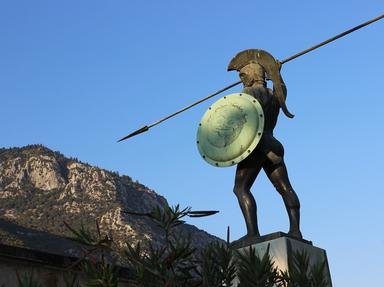Quiz Answer Key and Fun Facts
1. What is the ancient Greek name for the Spartan shortsword?
2. How long was the Spartan shortsword?
3. What was the total length of the Spartan spear?
4. Of what material was the Spartan spearhead made?
5. What did the uniform letter all Spartans bore on their shields stand for?
6. What did the Spartans wear on their feet during battle?
7. Of what two materials was the Spartan shield made of?
8. What did the grip of a Spartan shield look like?
9. What is the ancient Greek name for the Spartan shield?
10. What color was the crest of the Spartan helmet?
11. What type of crest did a Spartan platoon commander wear? (Kings also wore them).
12. What was the only vulnerable part of a hoplite's face with his helmet on?
13. Of what material was the helmet made?
14. What part of the body did the greaves cover?
15. What part of the body did the bracers cover?
16. What was different about the Spartan body armor than that of other Greeks?
17. How was the cuirass worn?
18. What was the purpose of the red cloak?
19. How was the cloak worn?
20. What did the Spartans wear under their cuirass?
Source: Author
lakedaemonian
This quiz was reviewed by FunTrivia editor
bloomsby before going online.
Any errors found in FunTrivia content are routinely corrected through our feedback system.


